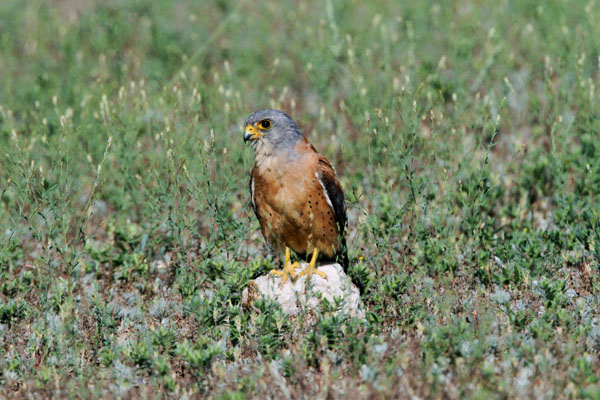Falco naumanni
IUCN
LCBasic Information
Scientific classification
- name:Falco naumanni
- Scientific Name:Yellow-footed Hawk
- Outline:Raptor
- Family:Falconiformes Falconidae Falco
Vital signs
- length:29-32cm
- Weight:124-225g
- lifetime:12-16year
Feature
The Yellow-clawed Hawk is one of the longest-migrating birds of prey. It is extremely active, bold and noisy, with a sharp call.
Distribution and Habitat
In my country, it breeds in suitable habitats in the north and is found from North China to the southwest during migration. Abroad, it is widely distributed in southern Europe, North Africa, West Asia, Central Asia, and southern Siberia, and winters in Africa, the Arabian Peninsula, and South Asia.
The yellow-clawed falcon is often seen alone, in pairs, or in groups in open habitats such as forest edges, wilderness, farmland, deserts, and river valleys. It especially likes to move in bare rock mountainous areas and wastelands with sparse trees. In the Tianshan area, it can even live in high mountain areas above 3,000 meters above sea level. It nests in depressions and caves on cliffs in mountainous areas, and occasionally in large tree holes. In some areas, it can gather in large groups of dozens of them and nest collectively in abandoned and destroyed buildings.
Appearance
The Yellow-clawed Hawk is a small bird of prey, a smaller falcon. It has no obvious wing fingers. It is very similar to the common Kestrel, but it does not often hover and is more slender. The central tail feathers of this species are more wedge-shaped and more prominent than those of the Kestrel, and its tail is relatively short, and its wing tips are not as sharp as those of the Kestrel. The male bird has a pure blue-gray head, with unclear sideburns, and a red back without spots, which can be clearly distinguished from the male Kestrel. When flying, looking up, you can see that its wings are whiter underside and the outer edges of its wings are black. The female bird and immature birds are very similar to the Kestrel, but the horizontal stripes on the back are slightly narrower, the vertical stripes on the chest and abdomen are sparser, and the sideburns are thinner than those of the Kestrel, but it is difficult to confirm in the wild. You can focus on observing its yellow or white
Details
The yellow-clawed falcon is a relatively rare bird. It is a summer migratory bird in Jilin, Liaoning, Hebei, Beijing, Xinjiang and other places in China, and a winter migratory bird in Yunnan. It usually migrates to its breeding grounds in the north from late March to mid-April, and leaves its breeding grounds from late October to early November. It is one of the raptors with the longest migration journey.
The yellow-clawed falcon usually moves in pairs and small groups. It often flies in the air and glides frequently. Its call is sharp. It mainly feeds on large insects such as locusts, grasshoppers, beetles, crickets, click beetles, beetles, etc., and also eats vertebrates such as rodents, lizards, frogs, small birds, etc. It usually preys on insects in the air. Sometimes it also preys on the ground.

The breeding season of the yellow-clawed falcon is from May to July. It nests in depressions on cliffs in mountain valleys or in caves or gravel on the top of rocks. Some nest in large tree holes. Usually 4-5 eggs are laid per nest, occasionally as many as 7 and as few as 3. The color of the eggs is white or light yellow, with brick red or reddish brown spots. The size of the eggs is 32-38 mm × 26-31 mm. The male and female birds take turns to incubate them, but the female bird is the main one, and the male bird only occasionally replaces the female bird during the day. The incubation period is 28-29 days. The chicks are late-maturing and are mainly fed by the male after hatching. After about 26-28 days of nesting, the chicks can fly and leave the nest.
The population of the yellow-clawed falcon is in a stable trend. The European population is estimated to be 50,000-84,000, half of which are located in Spain, and there are about thousands of individuals in Central Asia. The species has a wide distribution range and is not close to the vulnerable and endangered critical value standard for species survival. The population trend is stable, so it is evaluated as a species without survival crisis.








